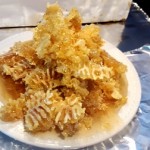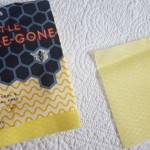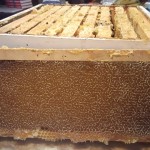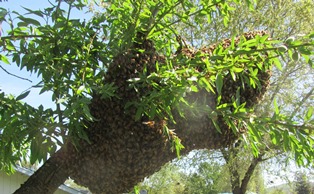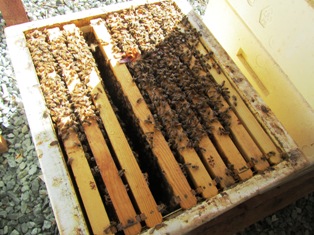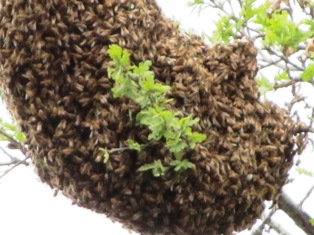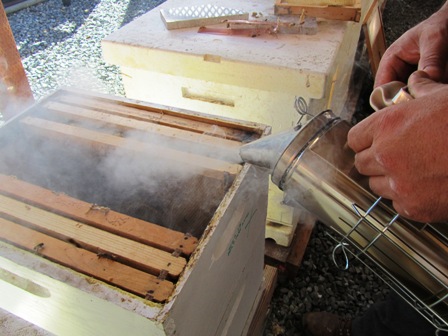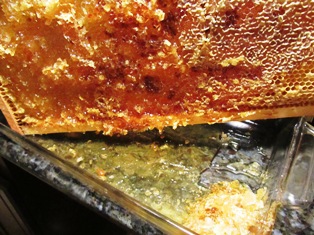Autumn Brings A Honey Harvest and Hive Treatment
Harvesting sweet-tasting, amber-colored honey from my hives has become an autumn ritual. This past Sunday, my beekeeper neighbor and I opened, inspected, and removed ten frames of honey from the one hive I have left.
The other hive succumbed to stress, a hive beetle infestation, and a steady march of ants. This despite me keeping my hives (and the apiary) pristine, dry, and facing the sun.
I found a beetle (no larvae) in the super we removed from the hive box when I scraped the frames clean of wax and bee glue. The tiny black insect had established itself in a crack under a plug of wax. Bees can’t sting through the beetle’s hard shell.
Without a powerful way of combating an infestation of beetles, the hive becomes stressed.Thank goodness, my neighbor had just the treatment to eliminate any other unseen beetles from my hive box.
Beetle Bee Gone sheets are an all natural and chemical-free method for treating hive beetle. Bees munch on the sheet that then becomes a fuzzy trap that ensnares the beetles. The beetles die.
In cool weather, which is what we have now, the hive beetle moves to the interior, above the brood, and/or under the hive cover. When the weather gets warmer, the pests move downward and so the placement of the sheets must be moved down.
My neighbor also inserted under the hive box lid a small plastic trough (as long as a pencil) with holes. He poured vegetable oil into the trough until it was half full. This, too, is a natural treatment against the hive beetle. The pests drown.
I’m optimistic that these treatments (along with others I’m using for mites) will keep the hive protected over winter so that in spring, I’ll get a new swarm to grow my diminished colony.
With the bees tended to, I turned my attention to the honey harvest. In all, the single super of ten frames produced roughly three gallons of honey once I’d prepped the frames and put them in the extractor. That’s more than enough honey to get my family through the winter and to present as gifts to friends along with jars of fruit jams and homemade sweets come Christmas.
_________________________________________________________________
If you enjoy reading about backyard beekeeping, caring for chickens, or growing organic vegetables, check out my Henny Penny Farmette series of books. All are available through traditional and online bookstores. To see more, click on the link.
Streak of Warm Weather Starts Seasonal Bee Swarms
Last Wednesday heralded the official onset of spring. And it sure felt like it around the East Bay. The local beekeepers became more watchful as increasing bee traffic predicted an increased likelihood of swarms.
Last year, we rescued more than a dozen swarms from neighborhood trees as far away as two miles. Bees will fly up to five miles in search of food (they also need water), returning to their hives before darkness and the cool night air sets in.
Swarming is the way honeybees increase their numbers. The queen lays eggs throughout the winter and in spring, the hive will need more room to accommodate all the new offspring. Beekeepers can add “extensions,” but swarms will still happen.
The first swarm of the season found its way to my almond tree on the day before Easter. I had vigorously pruned the branches two years ago after discovering some limbs badly diseased. But the tree rebounded with hundreds of small, thin branches. The weight of the massive swarm caused the branch to give way. The bee swarm fell apart.
In less than a minute, the honeybees were again huddled around their queen on a thicker, stronger branch.
A styrofoam super with frames already inserted was placed under the branch. All it took was a couple of hard shakes of the limb to knock the bees in their new home.
The lid of the super was reattached and the box positioned so that the opening (the bees’ front door) faced the tree. The swarm would find safe haven inside the super as night approached.
After dusk, the super was turned from its western-facing direction to ensure that the bees’ front door faced east, the direction of the sunrise. Bees love the light and warmth of the sun.
Around the top of the super, some of the honeybees did a tail-waggle dance. My beekeeper neighbor told me it was their way of telling the other bees that this was their new home; to, “come on in.”
I guess those little fellows doing the waggle dance were the welcoming party.
Bees: Upstairs, Downstairs
My neighbor’s honeybees, just like people, love the warm weather. They’ve been busily scouting out sources of pollen during this past week of springlike temperatures hovering in the upper 60s Farenheit on the Henny Penny Farmette.
I’ve put out a little pottery saucer, the size of a dinner plate, to hold a bit of water for the honeybees who are flocking to the feet of the little angel statue I placed in the center. The bees need something to stand on or they’ll drown. My beekeeper neighbor says wine bottle corks are great for giving the bees a support while they hover near the water to quench their thirst.
Bees, left undisturbed, will build a healthy and strong colony providing they have a food and water source and a a brood box or super in which to live. Of course, they could also take up residence in a hollow tree trunk or other wild place of their choosing. But supers are what beekeepers use.
As the colony grows, the bees will definitely need a super. During the summer months, adding a super on top of the brood box or other super gives the honeybees more room “upstairs.” There, they can store honey while “downstairs” the queen can lay more eggs in the cells of the brood box.
Seeing so much bee activity after a quiet winter, I’m ready to start planting annuals and perennial flowers with high pollen value that attract the bees. More food for the bees means more honey in the hive.
The Seductive Taste and Smell of Honey
The sweet, seductive scent of honey permeates the rear of my property where the honeybee traffic has picked up now that we have had a few warm days. My neighbor Peter told me on Saturday that we would open the hives today. I enjoy helping him with bees, and my organic yogurt wouldn’t taste the same without that sweet honey drizzled on top.
Peter says it’s coming on winter now and the bees need food. Sources of pollen diminish during fall and winter. Our inspection will determine whether or not the bees and their hives are in good shape. Most likely, if there is honey, we won’t harvest it but rather leave it for the bees. Still . . . if there’s an abundance, we might take a frame or two.
When he was just a boy, Peter received his training as a beekeeper from his father. His father’s honeybees kept their Lebanese village supplied with honey. Our purpose in opening the hives today is to inspect the physical structures of the hives for mold, mites, ants, or any foul smell that might suggest a problem.
We last medicated the bees during the first week of October. This morning, the bees were so docile, Peter didn’t even suit up. But I did. Even so, the last time I put on the head-to-toe bee suit and the elbow length leather gloves, I still got stung as I was removing the suit.
At approximately 9:30 a.m. , we started to open the hives, smoking each one, in turn and closely checking each frame. The hives all looked healthy and robust. We removed spent containers of Apigard and the hanging sticks of antibiotic.
After inspecting each frame in each hive, we re-medicated the bees to ward off mites and anything that might attack or weaken the immune systems of the bees. The goal is to keep them healthy and strong so that the honeybees survive with their babies through the winter to swarm in the spring (swarms are the way the bees expand their populations).
The last three hives were particularly strong. The bees were busily working. Each super (styrofoam box or hive that holds ten frames) was heavy. We reduced the sizes of the hives to two supers instead of a stack of three on top of each other. Smaller hives during the winter means less work for the bees to stay warm and make babies.
Peter handed me three frames of honey to take to my kitchen. He also took a frame or two. Tomorrow, I’ll make a honey cake . . . if I can stop myself from constantly sampling the gorgeous colored, sweet tasting honey that slowly drips from the frames into large glass dishes in my kitchen.
 Facebook
Facebook Goodreads
Goodreads LinkedIn
LinkedIn Meera Lester
Meera Lester Twitter
Twitter






